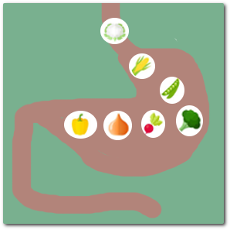
N U T R I T I O N
Food Digestion:Absorption & Transport
Homepage
Digesting Food: Nutrient Transport
Digestion transforms nutrients into more suitable forms for the body to use effectively by using many chemical reactions to break food down into molecules.
Before entering blood cells for transport, almost all nutrient molecules will converge with oxygen, creating stored energy.
These tiny nutrients are then sent into the bloodstream using several transport methods. Some nutrients can pass into the bloodtream on their own while others are transported by protein carriers.
Nutrient transport is a very precise chemical process as nutrients are sent where they are needed most and depending on whether it is protein(amino acids), carbs(glucose), or fats(fatty acids).
The Digestive System
Digestive system includes teeth, mouth, esophagus, stomach, small intestine, large intestine, pancreas, rectum, anus. Enzymes break down food we eat into a more suitable form our body can use.
Glands contributing digestive juices include the salivary glands, the gastric glands in the stomach lining, the pancreas, and the liver and its adjuncts—the gallbladder and bile ducts. All of these organs and glands contribute to the physical and chemical breaking down of ingested food and to the eventual elimination of nondigestible wastes. (Soutce: Britannica.com)
If we eat carbs they become glucose, protein becomes amino acids, and fat becomes fatty acid.
Through the process of mastication, or chewing, food is prepared in the mouth for transport through the upper digestive tract into the stomach and small intestine, where the principal digestive processes take place.
When the food we eat gets to our stomach, acids in the stomach help to break down the food into smaller components which then move into the small intestine where they are further reduced into tiny nutrients.
How Food Travels
From the stomach, it goes to small intestine; another 6 hours, and then enters your large intestine (colon) for further digestion, absorption of water and, finally, elimination of undigested food.
It takes about 36 hours for food to move through the entire colon.
All in all, the whole process — from the time you swallow food to the time it leaves your body as feces — takes about two to five days, depending on the individual. (Source: Mayo Clinic.org)
Food Digestion Times
Juices. Fruit and vegetable juices, vegetable broth: 15 to 20 minutes. Semi-liquids. Blended salads, vegetables, and fruit: 20 to 30 minutes.
Fruits. Watermelon: 20 minutes. Melons: 30 minutes. Orange, grapefruit, grapes: 30 minutes. Apples, pears, peaches, cherries, etc.: 40 minutes.
Vegetables. Salads (tomato, lettuce, cucumber, celery, bell peppers, other succulent vegetables): 30 to 40 minutes.
Starch. Corn, potatoes, sweet potatoes, yams, chestnuts: 60 minutes. Grains. Brown rice, millet, buckwheat, maize, oat flakes: 1.5 hours.
Beans. Lentils, chickpeas, peas, beans, 1.5 hours. Soybeans: 2 hours. Nuts and seeds. Sunflower, sesame, pumpkin seeds, and the like: 2 hours. Almonds, hazelnuts, peanuts, pecans, filberts, cashews, etc: 2.5 to 3 hours.
Dairy products. Skimmed milk, cheese and curd cheese lite 1.5 hours. Whole milk cottage cheese: 2 hours. Hard cheese: 4 to 5 hours.
Animal proteins. Egg yolk: 30 minutes. The whole egg with white: 45 minutes. Cod, flounder, seafood: 30 minutes. Salmon, trout, herring and other fatty fish: 45 to 60 minutes. Meats: beef, lamb, pork; 3 to 5 hrs.
Tips For Best Absorption:
Eat the easiest to digest first then other foods. Drink warm or hot liquids, not cold. Eat carbs at end of a meal.
YOU MAY LIKE:
Free Android Wine App
White Wines:Chardonnay, Chenin, Pinot Grigio, Sauvignon Blanc
Develop Android Apps - Free Tutorials Click Here
You May Also Like:
Make Sushi At Home | ProTips Photography |